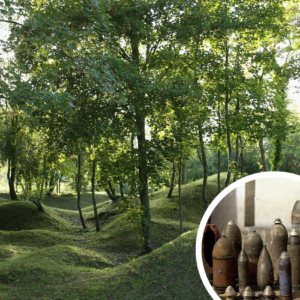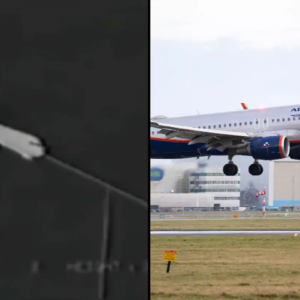Eerie WW2 Photos Captured Way More Than Expected
Two women stand amid the leveled ruins of the almshouse that was their home before a German bombing raid destroyed it in Newbury, England on February 11, 1943.
In the midst of World War II, the world was plunged into darkness. The horrors of war had spread like a deadly virus, engulfing everything in its path. The global conflict had impacted every facet of human life, leaving destruction and devastation in its wake. Amidst this bleak landscape, color photography served as a beacon of hope, offering a glimmer of light in a world shrouded in darkness.
These colorized photos of World War II provide a unique perspective on the most devastating conflict in human history. They offer a glimpse into the lives of soldiers and civilians alike, and showcase the resilience of the human spirit in the face of unimaginable adversity. Through these images, we are transported back in time, and invited to bear witness to the heroism, sacrifice, and tragedy that defined this monumental period in history. Join us on this journey through time, as we explore the vivid and haunting world of colorized World War II photography.

(U.S. Army/National Archives and Records Administration)
The Blitz, a violent and destructive campaign of bombing raids that targeted cities across Britain, was a turning point in the war, a moment of unbridled brutality that marked a shift in German bombing policy. Derived from the term blitzkrieg, or “lightning war,” the campaign was intended to demoralize the population and force surrender. But the tactic ultimately failed, as the British people rallied together in the face of adversity, their unbreakable spirit a testament to the power of the human will to endure and overcome.
The Blitz finally came to an end when Hitler’s forces were diverted to invade Russia, but small numbers of aircraft continued to carry out “tip and run” raids all over the country for the duration of the war. These raids, often targeting towns on the south coast of England, were indiscriminate and deadly, leaving a trail of destruction and death in their wake. The Palace Hotel Torquay was bombed twice in 1942, with the RAF hospital stationed there bearing the brunt of the destruction. And in March 1943, the town of Hastings was devastated, with 38 people killed and 40 houses destroyed in a single raid. The legacy of the Blitz would be felt for years to come, a haunting reminder of the cost of war and the resilience of the human spirit in the face of unimaginable hardship.
The entrance to the Nazis’ Auschwitz concentration camp in Poland soon after its liberation by Soviet troops, January 1945

(AFP/AFP/Getty Images)
The liberation of Auschwitz concentration camp in Poland in January 1945 was a pivotal moment in the history of the Holocaust. Soviet troops entered the camp and found the survivors, many of them emaciated and on the brink of death. The liberation exposed the horrors of the Nazi death machine, with evidence of mass killings, torture, and experimentation on human subjects. Despite the fact that the Soviet troops had initially entered the camp on January 27, it wasn’t until later that the full extent of the atrocities committed at Auschwitz became widely known. Today, the liberation of Auschwitz remains an important symbol of the triumph of good over evil, and a reminder of the atrocities committed by the Nazi regime during World War II.
See more









News
The “Red Zone” – Land Still Abandoned Due to the Dangers Left by the First World War
The “Red Zone” – Land Still Abandoned Due to the Dangers Left by the First World War In the aftermath of the First World War, large areas of northeast France were left in ruin. Years of constant siege warfare along…
Before Becoming a Big-Name Actor, Richard Todd was a Paratrooper Who Fought at Pegasus Bridge
Before Becoming a Big-Name Actor, Richard Todd was a Paratrooper Who Fought at Pegasus Bridge Photo Credit: 1. Sgt. Christie, No. 5 Army Film & Photographic Unit / Imperial War Museums / Wikimedia Commons / Public Domain 2. Silver Screen…
The Potsdam Giants: A Prussian Infantry Regiment Of Nothing But Very Tall Soldiers
The Potsdam Giants: A Prussian Infantry Regiment Of Nothing But Very Tall Soldiers Frederick William I inspecting his giant guards known as The Potsdam Giants, a Prussian infantry regiment No 6, composed of taller-than-average soldiers. Frederick William I of Prussia,…
Ellen DeGeneres cuts a very casual figure as she drives around in her Ferrari
Ellen DeGeneres cuts a very casual figure as she drives around Montecito in her Ferrari… while preparing to embark on her stand-up tour Ellen DeGeneres cut a very casual figure as she made her way around Montecito on Tuesday morning. The…
“I’m heavily tattooed and keep getting rejected for jobs – it’s not fair”
Heavily tattooed OnlyFans star, 23, with multiple piercings on her FACE slams TJ Maxx for rejecting her for a job – accusing retailer of unfairly judging her dramatic look A woman has accused TJ Maxx of rejecting her for a…
All 75 passengers killed in plane crash after pilot let his chirldren control the plane
Praying, turning the engine off by accident and letting KIDS play with the controls: The worst blunders made by pilots before a crash revealed Every time we board a plane, we put our lives in the hands of the pilot….
End of content
No more pages to load











